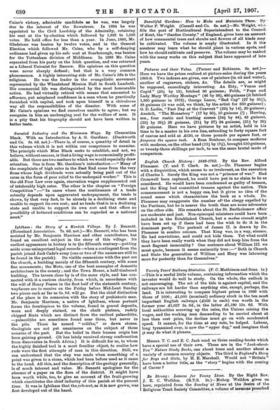Ightham the Story of a Kentish Village. By J. Bennett.
(Homeland Association. 7s. 6d. net.)--Mr. Bennett, who has been assisted by Mr. Benjamin Harrison and other contributors, has found an excellent subject in the story of this village. Its earliest appearance in history is in the fifteenth century—putting aside some unimportant legal records—when a contingent from the parish joined Jack Cade's army (one or two of the names are still to be found in the parish). Its visible connexions with the past are the church, a building mainly of the fifteenth century, with some fine monuments ; the Mote, one of the best examples of domestic architecture in the county ; and the Town House, a half-timbered building. The tavern close by is of the same style, and has con- nected with it a curious charity, from which, in accordance with the will of Henry Pearce in the first half of the sixteenth century, wayfarers are to receive on the Friday before Mid-Lent Sunday two pieces each as far as 6s. 85. will go. But the chief distinction of the place is its connexion with the story of prehistoric man. Mr. Benjamin' Harrison; a native of Ightbam, whose portrait forms the frontispiece to the volume, found in gravel deposits, worn and deeply stained, on the chalk plateau, rudely chipped flints which are distinct from the earliest palaeoliths, —palaeoliths are sometimes found near them, but never in the pits. These he named " eoliths," or dawn stones. Geologists are not yet unanimous on the subject of these remains of the past. But the belief in their human origin has been gaining ground. -(It has lately received strong confirmation from discoveries in South Africa.) It is difficult for us, to whom the highly finished tool is a most familiar object, to realise how rude were the first attempts of man in this direction. Still, we can understand that the step was made when something of a point was given to a stone, which had been before used as it came to the hand. All this, and the description of the geology generally, is of much interest and value. Mr. Bennett apologises for the absence of a paper on the flora of the district. It might have been worth while, too, to give an account of the fruit-growing which constitutes the chief industry of this parish at the present time. It was in Ightbam that the cob-nut, as it is now grown, was first developed out of the hazel.


























































 Previous page
Previous page